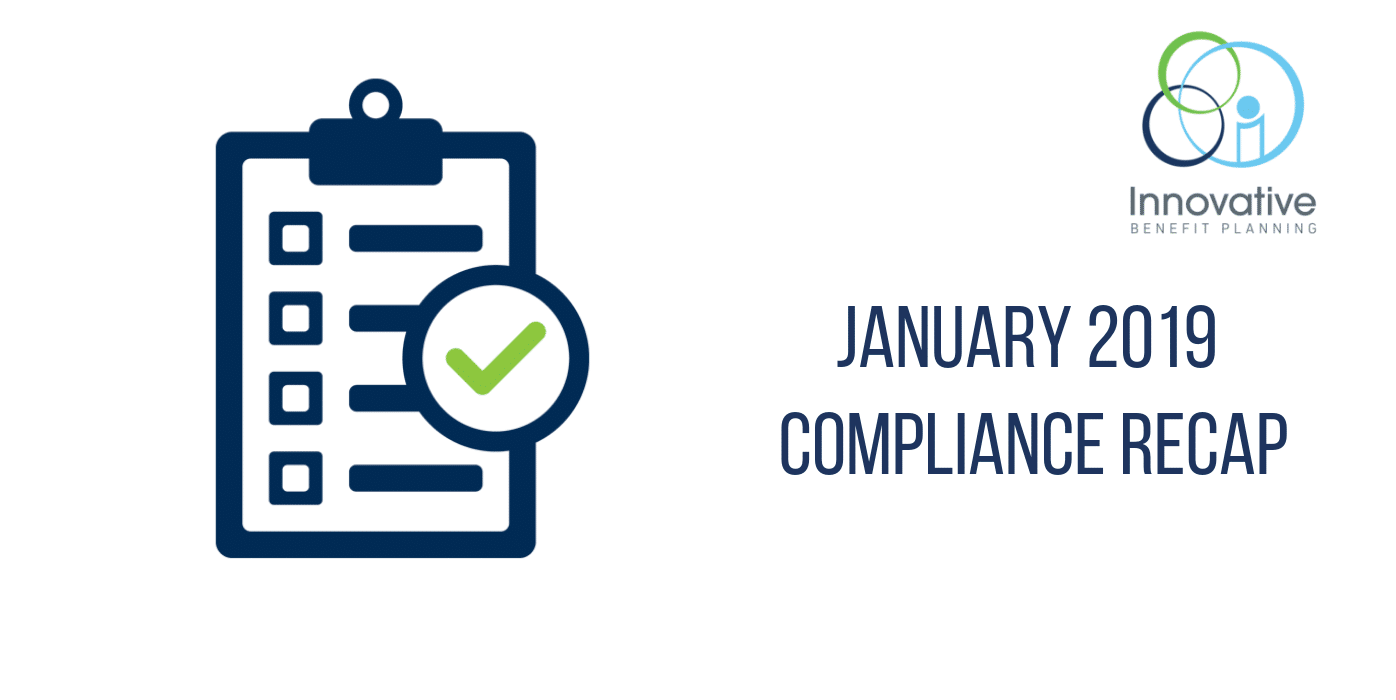January was a relatively quiet month in the employee benefits world.
The Department of Labor (DOL) issued its annual adjustment of federal civil monetary penalties. The Centers for Medicare & Medicaid Services released a proposed rule for benefit payment and parameters for 2020. The Internal Revenue Service (IRS) released its 2018 Instructions for Form 8994 Employer Credit for Paid Family and Medical Leave and final Form 8994.
The IRS released its “Tax Cuts and Jobs Act: A comparison for businesses” that provides a chart of how the Tax Cuts and Jobs Act changed deductions, depreciation, expensing, tax credits, and other tax items that affect employers.
Two federal district courts made rulings on the final rules regarding contraceptive coverage exemptions. The DOL released an information letter that explains ERISA’s preemption of certain state wage deduction laws.
The Congressional Research Service (CRS) issued an updated Affordable Care Act (ACA) Employer Shared Responsibility Provisions report that summarizes the ACA’s rules on determining whether an employer is an applicable large employer (ALE) and describes an ALE’s responsibilities to offer coverage.
DOL’s Annually Adjusted Federal Penalties
On January 23, 2019, the Department of Labor (DOL) issued its Federal Civil Penalties Inflation Adjustment Act Annual Adjustments for 2019 which is the DOL’s annual adjustment of federal civil monetary penalties.
Here are some of the adjustments:
- Form 5500: For failure to file, the maximum penalty increases from $2,140 to $2,194 daily for every day that the Form 5500 is late.
- Summary of Benefits and Coverage: For failure to provide, the maximum penalty increases from $1,128 to $1,156 per failure.
- Medicaid/CHIP notice: For failure to provide, the maximum penalty increases from $114 to $117 per day per employee.
- For failure to provide documents to the DOL upon its request, the maximum penalty increases to $156 per day, not to exceed $1,566 per request.
The adjustments are effective for penalties assessed after January 23, 2019, for violations occurring after November 2, 2015.
Proposed 2020 Benefit Payment and Parameters Rule
The Centers for Medicare & Medicaid Services (CMS) released a proposed rule for benefit payment and parameters for 2020. CMS also released its draft 2020 actuarial value calculator and draft 2020 actuarial value calculator methodology.
According to CMS, the proposed rule is intended to reduce fiscal and regulatory burdens associated with the Patient Protection and Affordable Care Act (ACA) across different program areas and to provide stakeholders with greater flexibility.
Although the proposed rule would primarily affect the individual market and the Exchanges, the proposed rule addresses the following topics that may impact employer-sponsored group health plans:
- Changes related to prescription drug policy
- Small Business Health Options Program (SHOP)
- Prohibition against discrimination
- Maximum annual limitation on cost sharing for plan year 2020
- Cost-sharing requirements for generic drugs
- Cost-sharing requirements and drug manufacturers’ coupons
CMS usually finalizes its benefit payment and parameters rule in the first quarter of the year following the proposed rule’s release. February 19, 2019, is the due date for public comments on the proposed rule.
The 2020 open enrollment period will run from November 1, 2019, to December 15, 2019.
Read more about the proposed rule.
IRS Releases Form and Instructions for Employer Credit for Paid Family and Medical Leave
The Internal Revenue Service (IRS) released its 2018 Instructions for Form 8994 Employer Credit for Paid Family and Medical Leave and its 2018 Form 8994.
As background, the Tax Cuts and Jobs Act (Act) included a new federal tax credit for employers that provide paid family and medical leave (FML) to their employees. The tax credit applies to wages paid to employees on FML in taxable years beginning after December 31, 2017, and before January 1, 2020.
The tax credit applies to employers who have a written policy that provides:
- Qualifying full-time employees with at least two weeks of annual paid FML;
- Qualifying part-time employees with an annual paid FML amount that is at least proportionate to the full-time employees’ annual paid FML amount; and
- A rate of pay not less than 50 percent of the wages normally paid to employees for services performed.
The tax credit applies to an employer’s qualifying employees who are:
- Employees as defined under Section 3(e) of the Fair Labor Standards Act of 1938, as amended;
- Employed by the employer for one year or more; and
- Not compensated in excess of 60 percent of the amount for highly compensated employees for the preceding year (for example, in 2018, employers may only apply the credit toward employees who did not earn more than $72,000 in 2017).
Read more about the employer credit for paid family and medical leave.
IRS Releases Chart of Business Deductions and Tax Credits Available to Employers
The Internal Revenue Service (IRS) released its Tax Cuts and Jobs Act: A comparison for businesses that provides a chart of how the Tax Cuts and Jobs Act (Act) changed deductions, depreciation, expensing, tax credits, and other tax items that affect employers.
This side-by-side comparison can help employers understand the Act’s changes and plan accordingly. Employers can find additional details and the latest resources at the IRS’ Tax Reform Provisions that Affect Businesses.
Recent Litigation on the Contraceptive Coverage Exemptions Rules
The Department of the Treasury (Treasury), Department of Labor (DOL), and Department of Health and Human Services (HHS) (collectively, the Departments) released two final rules on November 7, 2018, regarding contraceptive coverage exemptions. The final rules were published on November 15, 2018, to be effective on January 14, 2019. HHS also issued a press release and fact sheet on these final rules.
On January 13, 2019, the U.S. District Court for the Northern District of California granted a preliminary injunction that prohibits the final rules’ implementation and enforcement against the following states: California, Connecticut, Delaware, Hawaii, Illinois, Maryland, Minnesota, New York, North Carolina, Rhode Island, Vermont, Washington, the Commonwealth of Virginia, and the District of Columbia. These states will be subject to the contraception mandate exemption and accommodation rules that existed prior to the interim final rules, pending the final decision of this case.
On January 14, 2019, the U.S. District Court for the Eastern District of Pennsylvania granted a nationwide preliminary injunction that prohibits the implementation of the two final rules.
Read more about the court cases and the contraceptive coverage exemptions.
DOL Releases Information Letter on ERISA Preemption of State Wage Deduction Consent Laws
The Department of Labor (DOL) released its Information Letter to explain that ERISA preempts state laws that require employees’ written consent before deductions are withheld from their wages.
The DOL concluded that a state wage deduction law is preempted by Section 514(a) of ERISA to the extent that the state law is interpreted to limit, prohibit, or regulate an employer’s adoption of automatic enrollment arrangements in connection with a welfare benefit plan covered under Title I of ERISA, or making related deductions from wages for contribution to a welfare benefit plan.
Employers should keep in mind that DOL Information Letters are not binding precedents. While this Information Letter provides informal guidance to employers on how they may structure their premium deduction arrangements, an employer cannot rely on this Information Letter to defend its actions in court.
CRS Issues Updated Employer Shared Responsibility Provisions Summary
The Congressional Research Service (CRS) issued its updated The Affordable Care Act’s (ACA’s) Employer Shared Responsibility Provisions (ESRP) report that summarizes the ACA’s rules on determining whether an employer is an applicable large employer (ALE) and describes an ALE’s responsibilities to offer coverage.
At pages 19-20, the report includes a chart that lists different worker classifications (for example, full-time, part-time, student workers, controlled group employees, etc.) and how each type of worker is treated for purposes of ALE determination and applying employer shared responsibility provisions.
Question of the Month
- When the plan changes, when should I give notice to participants?
- Depending on the change that is made, an employer must provide notice within one of three time frames:
- 60 days prior to the change
- No later than 60 days after the change (or, within 60 days of the change)
- Within 210 days after the end of the plan year
For modifications to the summary plan description (SPD) that constitute a material reduction in covered services or benefits, notice is required within 60 days of adoption of the material reduction in group health plan services or benefits. For example, a decrease in employer contribution would be a material reduction in covered services or benefits so notice should be provided within 60 days of the change in employer contribution. As a best practice, an employer should give advance notice of the change. For practical purposes, employees should be told prior to the first increased withholding.
If a plan makes a material modification in any of the plan terms that would affect the content of the most recently provided summary of benefits and coverage (SBC), then notice must be provided no later than 60 days prior to the date on which the modification will become effective.
However, if the change is part of open enrollment, assuming you communicate the change during open enrollment, the open enrollment communication is considered acceptable notice, regardless of whether the SBC or the SPD, or both, are changing. Open enrollment is essentially a safe harbor for the 60-day prior/60-day post notice requirements.
Finally, changes that do not require more immediate notifications, because they do not affect the SBC and are not a material reduction in benefits, must be communicated through a summary of material modifications or an updated summary plan description within 210 days after the end of the plan year.
This information is general and is provided for educational purposes only. It reflects UBA’s understanding of the available guidance as of the date shown and is subject to change. It is not intended to provide legal advice. You should not act on this information without consulting legal counsel or other knowledgeable advisors. 












